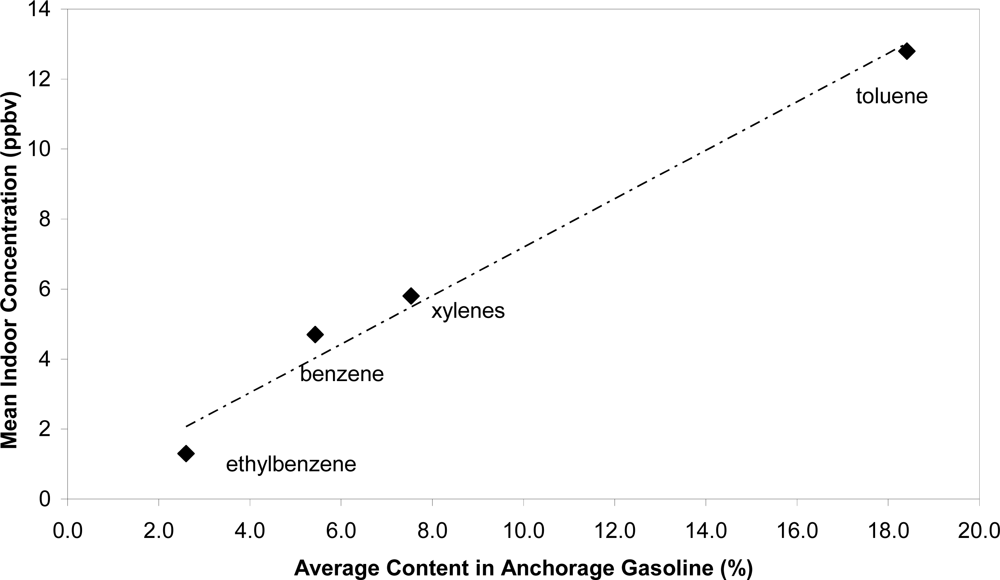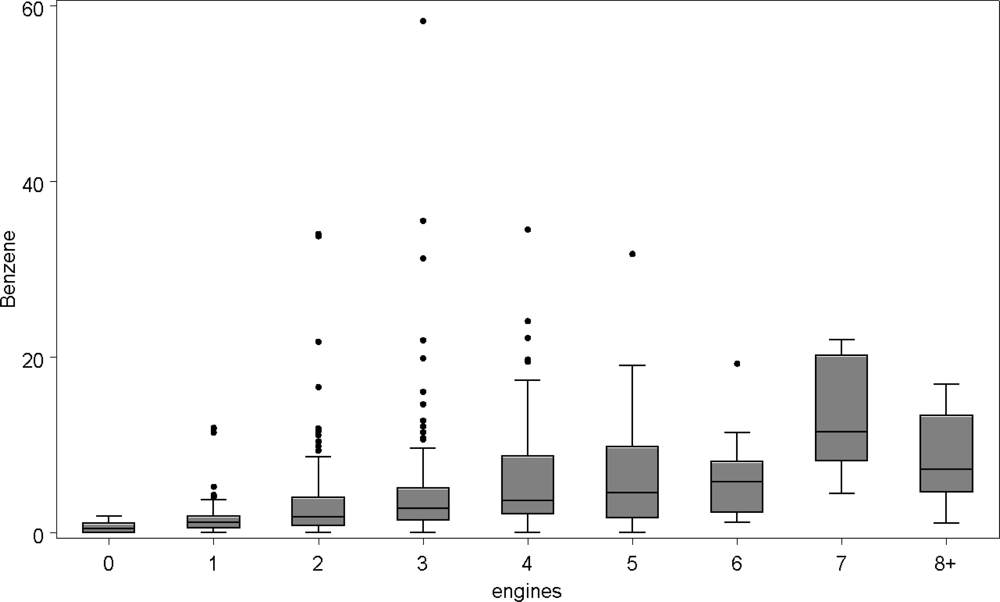Evaporative Gasoline Emissions and Asthma Symptoms
Abstract
:1. Introduction
2. Methods
- Has this person EVER had wheezing or whistling in his/her chest at any time?
- If yes, in the last 12 months, how many attacks of wheezing?
- How often has this person awakened from sleep with wheezing?
- Has wheezing ever been severe enough to limit his/her speech to 1 or 2 words between breaths?
- Has his/her chest ever sounded wheezy during or after exercise?
- Has this person used medications such as inhalers or pills to help breathing?
- Has this person had a dry cough at night without a cold or chest infection?
- High exposure >9 ppb of benzene
- Intermediate exposure ≥3 ppb and ≤9 ppb of benzene
- Low exposure <3 ppb of benzene
3. Results and Discussion
4. Discussion
5. Conclusions
Acknowledgments
References
- Air Quality in Anchorage: A Summary of Air Monitoring Data and Trends (1980–2008). March 2009; Available online: http://www.muni.org/Departments/health/environment/AirQ/Documents/2009%20report%20final.pdf/ (accessed on 23 April 2010).
- Schlapia, A; Morris, S. Architectural, behavioral and environmental factors associated with VOCs in Anchorage homes. Proceedings of the 91st Annual Meeting of the Air & Waste Management Association. San Diego, CA, USA, date Month1998; Document # 98-A504; Available online: http://www.muni.org/Departments/health/environment/Adobe%20Documents%20for%20ESD%20Site/Architectural%20Behavioral%20and%20Environmental%20Factors%201996.pdf (accessed on 26 April 2010).
- Morris, S. Influence of Attached Garages on Indoor VOC Concentrations in Anchorage Homes. proceeding of the Annual Meeting of Northwest International Section of the Air & Waste Management Association; Seattle, WA, USA, 2004. Available online: http://www.pnwis.org/PNWIS2004/Presentations/3.3.3%20Morris%20Indoor%20Air%20Q%20of%20Attached%20Garages.pdf (accessed on 23 April 2010).
- Batterman, S; Chunrong, J; Hatzivasilis, G. Migration of volatile organic compounds from attached garages to residences: A major exposure source. Environ. Research 2007, 104, 224–240. [Google Scholar]
- Dodson, RE; Levy, JI; Spengler, JD; Shine, JP; Bennett, DH. Influence of basements, garages and common hallways on indoor residential volatile organic compound concentrations. Atmos. Environ 2008, 42, 1569–1581. [Google Scholar]
- Pappas, GP; Herbert, RJ; Henderson, W; Koenig, JQ; Stover, B; Barnhart, S. The respiratory effects of volatile organic compounds. Int. J. Occup. Environ. Health 2000, 6, 1–8. [Google Scholar]
- Ware, JH; Spengler, JD; Neas, LM; Samet, JM; Wagner, GR; Coultas, D; Ozkaynak, H; Schwab, M. Respiratory and irritant health effects of ambient volatile organic compounds. Am. J. Epidemiol 1993, 137, 1287–1301. [Google Scholar]
- Arif, AA; Shah, SM. Association between personal exposure to volatile organic compounds and asthma among US adult population. Int. Arch. Occup. Environ. Health 2007, 80, 711–719. [Google Scholar]
- Brauer, M; Hoek, G; van Vliet, P; Meliefste, K; Fischer, PH; Wijga, A; Koopman, LP; Neijens, HJ; Gerritsen, J; Kerkhof, M; Heinrich, J; Bellander, T; Brunekreef, B. Air pollution from traffic and the development of respiratory infections and asthmatic and allergic symptoms in children. Am. J. Resp. Crit. Care Med 2002, 166, 1092–1098. [Google Scholar]
- Ciccone, G; Forastiere, F; Agabiti, N; Biggeri, A; Bisanti, L; Chellini, E; Corbo, G; Dell’Orco, V; Dalmasso, P; Volante, TF; Galassi, C; Piffer, S; Renzoni, E; Rusconi, F; Sestini, P; Viegi, G. Road traffic and adverse respiratory effects in children. SIDRIA Collaborative Group. Occup. Environ. Med 1998, 11, 771–778. [Google Scholar]
- Kim, JJ; Smorodinsky, S; Lipsett, M; Singer, BC; Hodgson, AT; Ostro, B. Traffic-related air pollution near busy roads: the East Bay Children’s Respiratory Health Study. Am. J. Resp. Crit. Care Med 2004, 170, 520–526. [Google Scholar]
- Shima, M; Nitta, Y; Adachi, M. Traffic-related air pollution and respiratory symptoms in children living along trunk roads in Chiba Prefecture, Japan. J. Epidemiol 2003, 3, 108–119. [Google Scholar]
- Thompson, AJ; Shields, MD; Patterson, CC. Acute asthma exacerbations and air pollutants in children living in Belfast, Northern Ireland. Arch. Environ. Health 2001, 56, 234–241. [Google Scholar]
- Brunekreef, B; Janssen, NA; de Hartog, J; Harssema, H; Knape, M; van Vliet, P. Air pollution from truck traffic and lung function in children living near motorways. Epidemiology 1997, 8, 298–303. [Google Scholar]
- Delfino, R; Gong, H; Linn, WS; Hu, Y; Pellizzari, ED. Respiratory symptoms and peak expiratory flow in children with asthma in relation to volatile organic compounds in exhaled breath and ambient air. J. Expos. Anal. Environ. Epidemiol 2003, 13, 348–363. [Google Scholar]
- Edwards, J; Walters, S; Griffiths, RK. Hospital admissions for asthma in preschool children: relationship to major roads in Birmingham, United Kingdom. Arch. Environ. Health 1994, 49, 223–227. [Google Scholar]
- Brunekreef, B; Stewart, AW; Anderson, HR; Lai, CKW; Strachan, DP; Pearce, N; et al.; ISAAC Phase 3 Study Group Self-Reported Truck Traffic on the Street of Residence and Symptoms of Asthma and Allergic Disease: A Global Relationship in ISAAC Phase 3. Environ. Health Perspect 2009, 117, 1791–1798. [Google Scholar]
- Duhme, H; Weiland, SK; Keil, U; Kraemer, B; Schmid, M; Stender, M; Chambless, L. The association between self-reported symptoms of asthma and allergic rhinitis and self-reported traffic density on street of residence in adolescents. Epidemiology 1996, 7, 578–582. [Google Scholar]
- van Vliet, P; Knape, M; de Hartog, J; Janssen, N; Harssema, H; Brunekreef, B. Motor vehicle exhaust and chronic respiratory symptoms in children living near freeways. Environ. Res 1997, 74, 122–132. [Google Scholar]
- Venn, AJ; Lewis, SA; Cooper, M; Hubbard, R; Britton, J. Living near a main road and the risk of wheezing illness in children. Am. J. Resp. Crit. Care Med 2001, 164, 2177–2180. [Google Scholar]
- Zmirou, D; Gauvin, S; Pin, I; Momas, I; Sahraoui, F; Just, J; Le Moullec, Y; Brémont, F; Cassadou, S; Reungoat, P; Albertini, M; Lauvergne, N; Chiron, M; Labbé, A; et al. Vesta investigators. Traffic related air pollution and the incidence of childhood asthma: results of the Vesta case-control study. J. Epidemiol. Community Health 2004, 58, 18–23. [Google Scholar]
- Rumchev, K; Spickett, J; Bulsara, M; Phillips, M; Stick, S. Association of domestic exposure to volatile organic compounds with asthma in young children. Thorax 2004, 59, 746–751. [Google Scholar]
- Gordian, ME; Haneuse, S; Wakefield, J. An investigation of the association between traffic exposure and the diagnosis of asthma in children. J. Expo. Sci. Environ. Epidemiol 2006, 16, 49–55. [Google Scholar]
- McConnell, R; Berhane, K; Yao, L; Jerrett, M; Lurmann, F; Gilliland, F; Künzli, N; Gauderman, J; Avol, E; Thomas, D; Peters, J. Traffic, susceptibility, and childhood asthma. Environ. Health Perspect 2006, 114, 766–772. [Google Scholar]
- Agency for Toxic Substances and Disease Registry Minimal Risk Levels. 1 Sept 2009; Available online: http://www.atsdr.cdc.gov/mrls/mrls_list.html/ (Accessed on 23 April 2010).


| Demographic | Category | Number (%) |
|---|---|---|
| Gender | Female Male Missing | 761 (50.8%) 719 (48.0%) 4 (0.2%) |
| Race | Caucasian Asian/PI Mixed race Black Am.I/Alaska Native Other Missing | 1,263 (85.1%) 82 (5.5%) 55 (3.7%) 26 (1.8%) 26 (1.8%) 24 (1.6%) 8 (0.5%) |
| Age | 0–19 20–65 66+ missing | 458 (30.6%) 1,010 (67.5%) 13 (0.9%) 3 (0.2%) |
| Employment | Yes No | 826 (55.7%) 658 (44.3%) |
| Current Smokers (Individuals) | Yes No missing | 55 (4%) 1,424 (96%) 5 (0.3%) |
| Smokers live in household (Households) | Yes No missing | 46 (8.9%) 463 (89.9%) 6 (1.2%) |
| Benzene | Toluene | Ethylbenzene | Xylenes | ||
|---|---|---|---|---|---|
| N | 509 | 509 | 509 | 509 | |
| Median (ppb) | 2.88 | 7.34 | 0.83 | 3.01 | |
| Minimum (ppb) | <0.4 | <1.8 | <0.7 | <2.5 | |
| Maximum (ppb) | 58.29 | 179.17 | 13.74 | 77.26 | |
| Concentration by Percentiles (ppb) | 25th | 1.19 | 3.03 | 0.34 | <2.5 |
| 75th | 5.92 | 14.68 | 1.74 | 8.05 | |
| 90th | 11.16 | 27.36 | 3.15 | 14.14 | |
| Exposure | Individuals | Households* | Median benzene level |
|---|---|---|---|
| Low <3ppb | 791 | 275 | 1.25 ppb |
| Intermediate 3–9 ppb | 439 | 162 | 4.75 ppb |
| High > 9 ppb | 252 | 81 | 12.27 ppb |
| % reporting symptom within each exposure group | Odds ratio of having the symptom with the referent being low exposure <3 ppb | ||||
|---|---|---|---|---|---|
| Symptom | Low exposure <3 ppb N = 787 | Intermediate exposure (3–9 ppb) N = 441 | High exposure >9 ppb N = 252 | Intermediate Exposure (3–9 ppb) Odds ratio (95% CI) | High Exposure (>9ppb) Odds ratio (95% CI) |
| Wheeze | 12.8 | 13.7 | 14.2 | 1.03 (0.63,1.68) | 1.15 (0.63,2.09) |
| Asthma attacks | 4.0 | 4.1 | 6.5 | 1.06 (0.52,2.17) | 1.80 (0.80,4.06) |
| Wheezing Sleep disturbance | 0.8 | 1.2 | 0.8 | 1.23 (0.32,4.64) | 1.00 (0.17,5.88) |
| Exercise-induced asthma | 11.8 | 13.7 | 15.4 | 1.28 (0.76,2.13) | 1.48 (0.80,2.76) |
| Dry Cough | 14.1 | 14.2 | 17.9 | 1.06 (0.64,1.74) | 1.49 (0.81,2.73) |
| Diagnosed Asthma | 12.4 | 13.1 | 12.5 | 1.04 (0.67,1.63) | 1.06 (0.61,1.85) |
| Allergies | 30.8 | 31.0 | 30.8 | 1.11 (0.77,1.61) | 1.13 (0.72,1.79) |
| Severe asthma * | 5.4 | 6.3 | 10.6 | 1.34 (0.70,2.54) | 2.49 (1.22,5.07) |
© 2010 by the authors; licensee Molecular Diversity Preservation International, Basel, Switzerland. This article is an open-access article distributed under the terms and conditions of the Creative Commons Attribution license (http://creativecommons.org/licenses/by/3.0/).
Share and Cite
Gordian, M.E.; Stewart, A.W.; Morris, S.S. Evaporative Gasoline Emissions and Asthma Symptoms. Int. J. Environ. Res. Public Health 2010, 7, 3051-3062. https://doi.org/10.3390/ijerph7083051
Gordian ME, Stewart AW, Morris SS. Evaporative Gasoline Emissions and Asthma Symptoms. International Journal of Environmental Research and Public Health. 2010; 7(8):3051-3062. https://doi.org/10.3390/ijerph7083051
Chicago/Turabian StyleGordian, Mary Ellen, Alistair W Stewart, and Stephen S Morris. 2010. "Evaporative Gasoline Emissions and Asthma Symptoms" International Journal of Environmental Research and Public Health 7, no. 8: 3051-3062. https://doi.org/10.3390/ijerph7083051
APA StyleGordian, M. E., Stewart, A. W., & Morris, S. S. (2010). Evaporative Gasoline Emissions and Asthma Symptoms. International Journal of Environmental Research and Public Health, 7(8), 3051-3062. https://doi.org/10.3390/ijerph7083051




